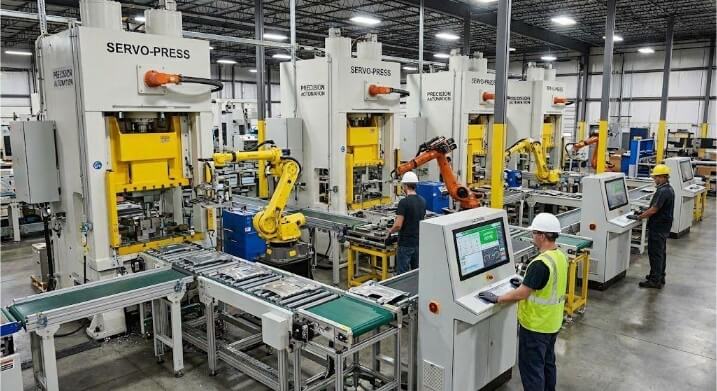When assembling metal parts, loose connections and weak joints can lead to serious failures. Some fasteners are expensive or complicated to install. Others require special tools. Many engineers and buyers look for a method that’s strong, low-cost, and simple. Rivets offer a clean, fast, and durable way to join metal sheets. But with so many types and techniques, how do you choose the right one?
Rivets are permanent mechanical fasteners used to hold sheet metal parts together. Let’s break down how rivets work, their types, and how to choose the best one for your project.
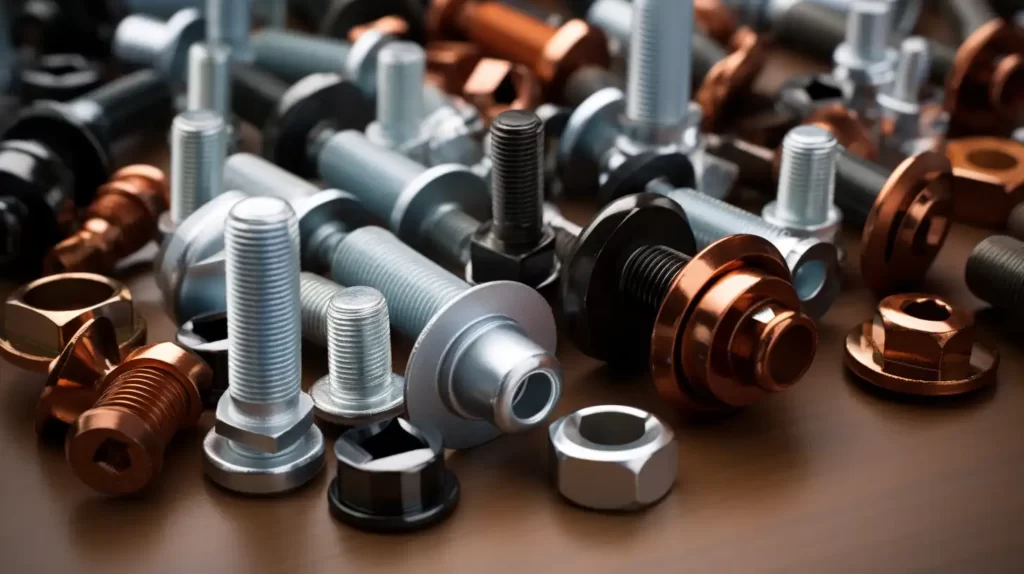
What Are Sheet Metal Rivets?
Sheet metal rivets are simple fasteners that hold two or more metal parts together. Each rivet has a head and a tail. When installed, the tail deforms and locks the parts tightly.
Rivets are useful when welding isn’t an option. They are strong, light, and easy to install. They work well with thin sheets and dissimilar metals. You can also install them from one side if needed.
Many industries use rivets in place of welds or screws. They offer consistent strength and are cost-effective in both prototyping and mass production.
Riveting vs. Welding: A Quick Comparison
Welding fuses metal with heat, while riveting connects parts with force. Riveting is faster and doesn’t need shielding gas or cleanup. Welds can distort thin metal or damage coatings. Rivets avoid these risks.
Rivets work well when you need to avoid heat or protect finishes. They are also easier to inspect and replace. Welding is stronger for heavy loads, but it takes more skill and equipment.
Use riveting when speed, simplicity, or surface protection matters. Use welding when high loads or sealed joints are required.
Types of Rivets Used in Sheet Metal Fabrication
Each type of rivet offers different benefits depending on your part design, load needs, and access limits. Here’s a quick look at the most common ones used in metalworking.
Solid Rivets
Solid rivets are one-piece fasteners with a head and a plain shaft. You insert them into a hole, then hammer or press the tail to form a second head.
These rivets are very strong. They’re used in aircraft, heavy machinery, and structural frames. You need access to both sides of the part to install it. Solid rivets work best when you want maximum strength and permanent joints.
Blind (Pop) Rivets
Blind rivets, or pop rivets, are made for one-sided access. They come with a mandrel that pulls through the body during installation. This expands the rivet and locks it in place.
They’re great for quick assembly and tight spots. You can use them on sheet metal, plastic, or thin materials. Blind rivets are standard in enclosures, electronics, and light-duty parts. They’re not as strong as solid rivets but are easier to install.
If you want to buy a large quantity of sheet metal rivets. you can look for reliable blind rivet manufacturers.
Semi-Tubular Rivets
Semi-tubular rivets have a hollow tip. This makes it easier for them to form with less force. You still need access to both sides, but installation is faster than with solid rivets.
They are often used in hinges, brake linings, and mechanical linkages. The hollow end helps absorb shock and vibration. Semi-tubular rivets strike a balance between strength and speed.
Drive Rivets
Drive rivets look like solid rivets but are installed by hammering a pin into the center. This expands the tail and locks the rivet.
They are suitable for thin materials and one-sided access. You’ll see them in signs, tags, and lightweight panels. Drive rivets are fast and clean, but not for high-load parts.
Structural Rivets
Structural rivets are heavy-duty blind rivets. They expand inside the hole and lock in with a high clamping force. Many types use a locking mechanism that keeps the mandrel in place for added strength.
These rivets are used in truck frames, railcars, and bridges. They replace bolts or welds in many cases. Use structural rivets when strength, speed, and one-sided access are all needed.
Self-Piercing Rivets
Self-piercing rivets don’t need pre-drilled holes. You press them through the top sheet and into the lower sheet. The rivet flares out underneath and locks both sheets.
They are fast and accurate. You’ll see them in automotive body panels and appliance housings. These rivets work best with soft or coated materials and automated lines.
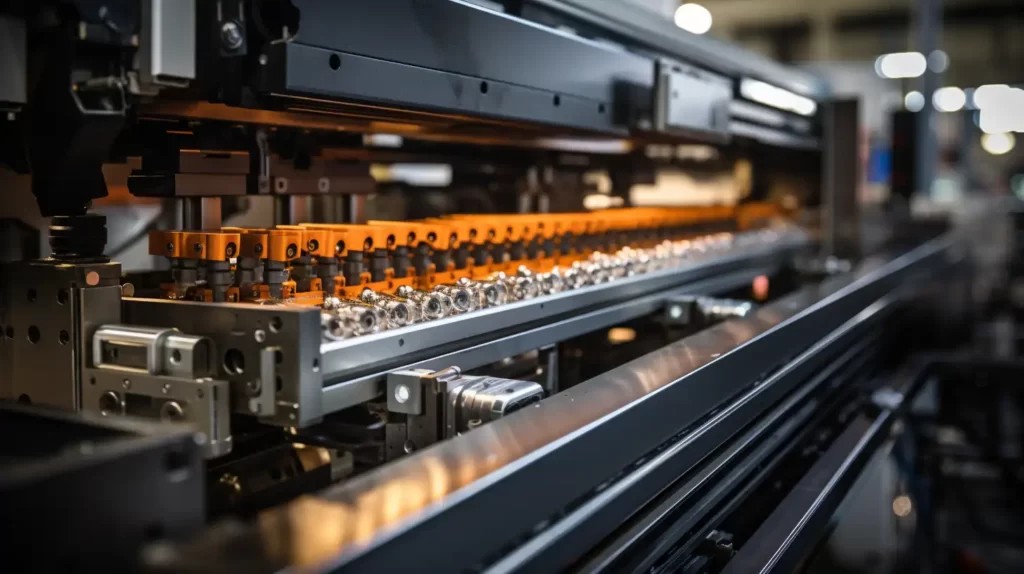
Materials for Rivets
The material of a rivet affects its strength, corrosion resistance, and how it interacts with the base metal. Choosing the right one helps avoid rust, fatigue, or part failure.
Aluminum Rivets
Aluminum rivets are lightweight and corrosion-resistant. They are easy to install and don’t need much force to deform. These rivets work well with aluminum or soft sheet metals.
They’re often used in HVAC systems, electronics, and low-load structures. They’re not the best choice for high-strength applications. Use aluminum rivets when weight savings and corrosion resistance matter more than load-bearing strength.
Stainless Steel Rivets
Stainless steel rivets are strong and resist rust. They are harder to deform, so installation needs more force or special tools.
They’re used in marine, outdoor, and food-grade applications. They hold up well under heat, moisture, and vibration. Choose stainless rivets for parts exposed to harsh environments or heavy stress.
Copper Rivets
Copper rivets are soft and easy to form. They conduct electricity and resist corrosion, especially in moist conditions.
You’ll find them in electrical parts, roofing, and decorative panels. They’re also used in leatherwork and older architectural designs. Copper works well when you need conductivity or a rustic look.
Monel and Specialty Alloys
Monel rivets are made from a nickel-copper alloy. They resist saltwater corrosion and high temperatures. These are used in aerospace, marine, and chemical equipment.
Other specialty rivets include titanium or brass. These serve niche applications where specific strength, weight, or chemical properties are needed. Use alloy rivets when standard materials can’t meet the job’s demands.
Choosing the Right Rivet
The proper rivet depends on how much load your joint needs to handle, what metals you’re joining, and where the part will be used. A poor match can cause cracks, corrosion, or failure over time.
Matching Rivet Material to Base Metal
Use similar metals when possible. This avoids galvanic corrosion, which happens when dissimilar metals touch in moist or salty environments.
For example, aluminum rivets with aluminum panels can be used. Use stainless rivets with stainless steel sheets. If you must mix, add a barrier or coating to reduce corrosion.
Strength Requirements and Shear Load
Check how much force the joint will face. If parts slide or shift under load, you’ll need rivets that resist shear force.
Solid or structural rivets handle higher loads. Blind and semi-tubular ones are better for medium or light-duty jobs.
Environmental and Corrosion Considerations
If your part faces moisture, salt, or chemicals, use corrosion-resistant rivets. Stainless steel and Monel perform well in wet or coastal areas.
For indoor or dry spaces, aluminum or coated steel may be enough. Don’t forget about temperature—some metals expand or weaken with heat.
Head Styles: Dome, Flat, Countersunk, and More
The head style affects the part’s look, clearance, and how it handles load. Dome heads are standard and strong. Flat heads sit lower but spread the load more.
Countersunk heads lie flush with the surface. These are best when you want a smooth finish, like in enclosures or panels.
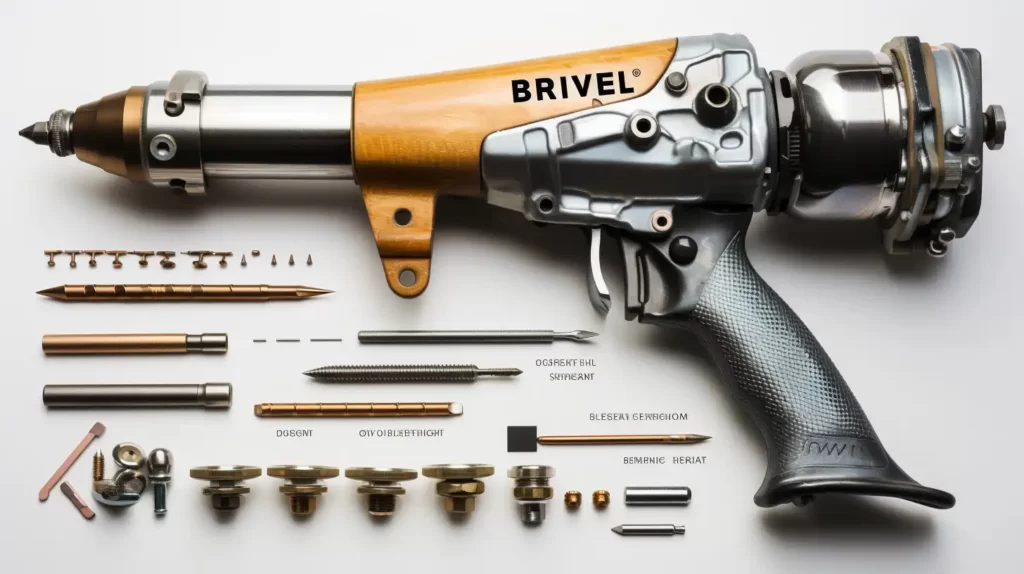
Tools and Equipment for Riveting
The right tool makes riveting faster, cleaner, and more consistent. Your production scale, material thickness, and rivet type will guide your tool choice.
Manual Rivet Guns
Manual rivet guns are hand tools used for blind rivets. You insert the rivet, squeeze the handles, and the mandrel pops.
They are low-cost and straightforward to use. Great for small jobs, repairs, or low-volume assembly. However, they require effort and can cause fatigue if used often. Not ideal for thick materials or large-scale work.
Pneumatic Rivet Tools
Pneumatic rivet guns use compressed air to install rivets quickly. They reduce effort and speed up production.
These tools are standard in mid- to high-volume shops. They offer good consistency and are easy to handle. You’ll need an air supply and regular maintenance, but the speed and ease are worth it for many teams.
Hydraulic Riveting Systems
Hydraulic rivet systems provide high force and precision. They are used for solid and structural rivets in heavy-duty builds.
You’ll find them in aerospace, automotive, and industrial production lines. These machines can handle thicker metals and harder rivets. They cost more and take up more space, but offer unmatched power and control.
Rivet Squeezers and Bucking Bars
These are used for solid and semi-tubular rivets. A rivet squeezer presses the rivet to form the head. A bucking bar supports the tail side while a hammer or rivet gun strikes the head.
This setup needs access to both sides of the part. It takes skill but creates robust joints. Used in aerospace, rail, and heavy sheet metal work. They’re great for precision and strength where pop rivets fall short.
Rivet Installation Process
Installing rivets may look simple, but skipping steps or using the wrong method can weaken the joint. Follow a straightforward process to get clean, tight, and reliable results.
Step-by-Step Blind Rivet Installation
- Drill the hole: Match the drill bit to the rivet diameter. Make sure the hole is clean and free of burrs.
- Insert the rivet: Slide the rivet into the hole until the head sits flush on the surface.
- Place the tool: Insert the mandrel into the rivet gun.
- Squeeze the handle: The tool pulls the mandrel, expanding the back side of the rivet.
- Mandrel snaps off: Once the rivet is tight, the mandrel breaks away, and the joint is complete.
Installing Solid Rivets with a Bucking Bar
- Drill and deburr the hole: Use the correct bit size. Clean and prep the hole edges.
- Insert the rivet: Push the solid rivet through the sheets until the head rests on the surface.
- Support with a bucking bar: Place the bar behind the tail side of the rivet.
- Hammer the head: Use a rivet gun or pneumatic hammer to shape the tail into a second head.
- Check the result: The formed tail should be round and tight. No gaps or tilt.
Common Issues During Installation and Fixes
- Loose rivets: Often caused by oversized holes. Use the correct drill size and check the fit before installing.
- Cracked sheets: Can result from using rivets that are too large or applying too much force. Use backing and a proper hole size.
- Mandrel sticks out: Usually a sign of an incomplete set. Re-squeeze with the rivet gun until the mandrel breaks.
- Misaligned holes: Use clamps to hold sheets in place before drilling. Drill both sheets at once if possible.
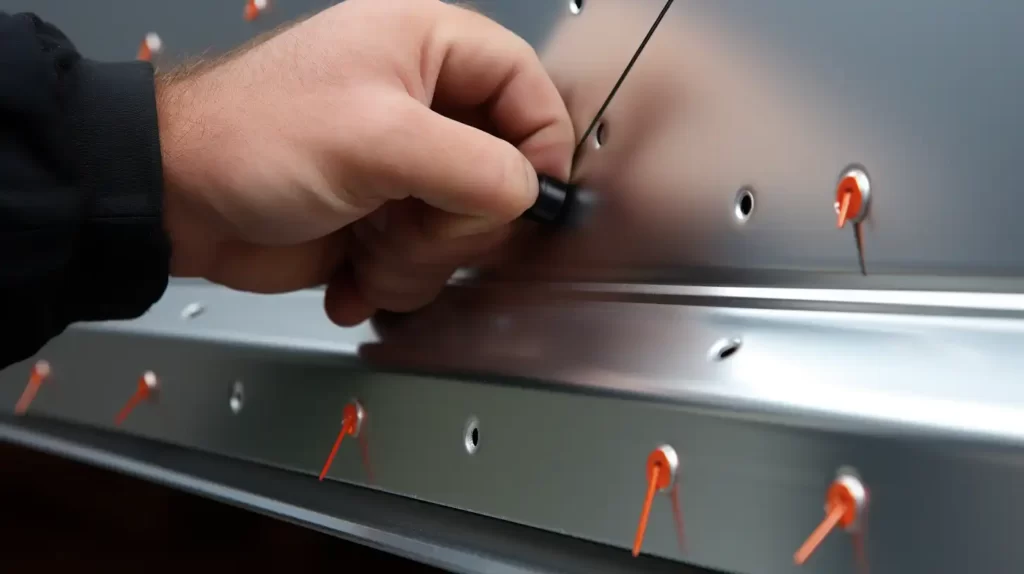
Riveting Techniques and Best Practices
A strong rivet joint starts with clean prep and correct steps. Poor technique can lead to weak joints, loose rivets, or damage to the metal.
Drilling Proper Hole Sizes
The hole must match the rivet size. Too tight, and the rivet won’t go in. If it is too loose, the joint will be weak.
Use sharp drill bits and match the bit size to the rivet diameter. Check the fit before setting the rivet. For blind rivets, follow the manufacturer’s size chart.
Deburring and Hole Preparation
Burrs around the hole can prevent a flush fit or damage the rivet. Use a deburring tool to smooth the edges.
Clean the surface and remove chips before placing the rivet. This helps the rivet seat properly and avoids misalignment. Proper hole prep reduces stress points and improves long-term durability.
Proper Rivet Length and Grip Range
Rivets come in different lengths for different material stacks. Use the right length so the rivet fills the hole and clamps the layers tightly.
Check the grip range, which is the total thickness the rivet can hold. Too short, and the joint won’t hold. Too long, and it won’t set correctly. Measure your sheet thickness and use the grip range to guide your choice.
Setting the Rivet: Manual vs. Power Methods
Manual tools are fine for low-volume jobs or repairs. Squeeze until the rivet sets or the mandrel breaks off.
Power tools offer speed and consistency for high volume or thicker materials. Pneumatic or hydraulic tools reduce fatigue and improve clamping. Choose the method based on your volume, access, and rivet type.
Preventing Panel Distortion and Cracking
Thin sheets can warp or crack during riveting. To avoid this, use backing bars or clamps to hold panels flat.
Make sure the hole is clean and the rivet is the right size. Apply even pressure during setting. If needed, use washers or support plates to spread the load and protect fragile parts.
Riveting in Specialized Industries
Some industries use rivets in particular ways. Each has its own set of needs, such as high strength, tight tolerances, or safety standards. Here’s how riveting plays a role in a few key sectors.
Aerospace Riveting Standards
In aerospace, rivets must handle extreme stress and vibration. Solid rivets are the top choice because of their strength and reliability.
Automotive Applications
Cars and trucks use a mix of rivet types. Self-piercing rivets are standard in body panels. Blind rivets are used for brackets and trim. Structural blind rivets are used in frames, doors, and battery trays for EVs.
Electronics and Enclosures
In electronics, space is tight. Rivets must be small but still secure. Micro blind rivets work well in control panels, enclosures, and circuit housings.
Medical Devices
Medical devices need clean, smooth, and corrosion-resistant fasteners. Stainless steel or titanium rivets are standard.
Conclusion
Sheet metal rivets are a reliable, low-cost way to join metal parts. From simple blind rivets to structural fasteners, each type has its place. Choosing the proper rivet depends on your material, joint strength, access, and environment. Good prep, proper tools, and correct techniques help ensure clean, strong connections every time.
Need help selecting the proper rivet for your project? Get expert support on material choice, fastener options, and production-friendly designs. Contact us today for fast solutions and reliable results.
Hey, I'm Kevin Lee

For the past 10 years, I’ve been immersed in various forms of sheet metal fabrication, sharing cool insights here from my experiences across diverse workshops.
Get in touch

Kevin Lee
I have over ten years of professional experience in sheet metal fabrication, specializing in laser cutting, bending, welding, and surface treatment techniques. As the Technical Director at Shengen, I am committed to solving complex manufacturing challenges and driving innovation and quality in each project.




